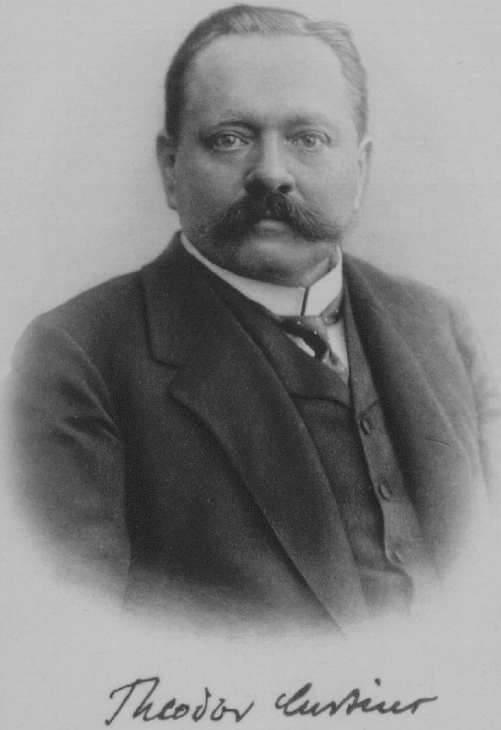- Theodor Curtius
Infobox_Scientist
name = Otto von Fürth
image_width = 200px
caption = Theodor Curtius, approx. 1880
birth_date = birth date|1857|5|27
birth_place =Duisburg Germany
residence =
nationality = German
death_date = death date and age|1928|2|8|1857|5|27
death_place =Heidelberg Germany
field =
work_institution =University of Heidelberg
alma_mater =
doctoral_advisor =Hermann Kolbe
doctoral_students =
known_for =
prizes =
religion =
footnotes =Geheimrat Professor Dr. Julius Wilhelm Theodor Curtius (27 May 1857 —8 February 1928 ) was professor of Chemistry atHeidelberg University and elsewhere. He published theCurtius rearrangement in 1890/1894 and also discovereddiazoacetic acid ,hydrazine andhydrazoic acid .History
Theodor Curtius was born in
Duisburg in the Ruhr area inGermany . He studied chemistry withRobert Bunsen atHeidelberg University and withHermann Kolbe atLeipzig University . He received his doctorate in 1882 in Leipzig.After working from 1884 to 1886 for
Adolf von Baeyer at theUniversity of Munich , Curtius became the director of the analytical chemistry department at University of Erlangen until 1889. Then he accepted the chair in Chemistry at theUniversity of Kiel , where he remained very studious, writing numerous articles and publications. In line with this success, Curtius was appointed Geheim Regierungsrat (Privy Councillor ) in 1895. After a one-year appointment as the successor of the famous Friedrich Kekulé atBonn University in 1897, Curtius succeededVictor Meyer as Professor of Chemistry at his old university in Heidelberg, in 1898, where he remained until his retirement in 1926. He was succeeded byKarl Freudenberg , who wrote Curtius' biography in 1962.Ref|Freudenberg-1962In his free time, he also composed music, sang in concerts, and was an active mountaineer. In 1894 he founded the Kiel section of the Association of German and Austrian Alpinists, which he personally supported with gifts. In his Munich time, he became close friend with alpinist guide
Christian Klucker , with whom he made mountaineering hikes for many years after.Theodor Curtius died in Heidelberg.
Major publications by Curtius
Curtius has written over 300 articles and publications. Several had a significant impact on chemical science.
* Diazo- und Azoverbindungen der Fettreihe, Barth, Leipzig (1888)
* Studien mit Hydrazin, Barth, Leipzig, Bd 1,2 (1896), Bd 3,4 (1918)
* Einwirkung von Basen auf Diazoessigester, Berlin (1911)
* Die reduktion der aromatische Aldazine und Ketazine, Barth, Leipzig (1912)
* Hydrazide und Azide der Azidofettsäuren, Berlin (1912)
* Die Einwirkungen von Hydrazin auf Nitroverbindungen, Barth, Leipzig (1913)* "Berichte", 1885, 18, 2373
* "Berichte", 1890, 23, 3023
* "J. Prakt. Chem. [2] ", 1894, 50, 275Curtius family
The Curtius family is historically from Bremen area. Several other members of the family became of note. See
Curtius for further informationReferences
# cite journal
title = Obituary: Theodor Curtius. 1857-1928
author = Karl Freudenberg
journal = Chemische Berichte
volume = 96
issue = 4
pages = I–XXV
year = 1963
url =
doi =10.1002/cber.19630960434External links
* [http://www.chem.qmul.ac.uk/rschg/biog.html#C Royal Society of Chemistry, Historical Group, short biography of Curtius]
* [http://www.uni-kiel.de/anorg/lagaly/group/klauskolgesch/d_klaus.htm#27 University of Kiel history of the inorganic department]
* [http://www.uni-heidelberg.de Heidelberg University]
* [http://www.dav-kiel.de German Alpen Association, Kiel section]
Wikimedia Foundation. 2010.
